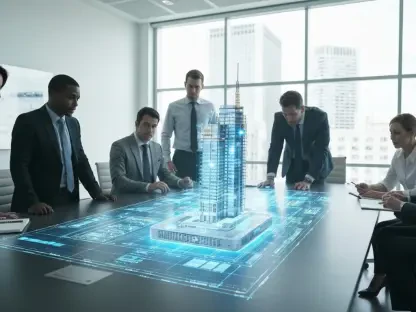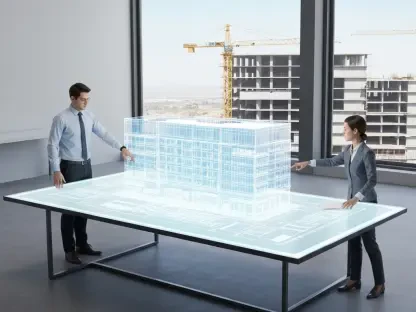Picture a world where the windows of every building not only frame a view but also actively combat energy waste, slash utility bills, and protect the environment from further strain, while a pioneering development by researchers at Central South University of Forestry and Technology in Changsha, China, brings this vision to life with an innovative material blending bamboo with tungsten-vanadium oxide (W-VO2). This cutting-edge technology, recently highlighted in a prominent journal, offers a fresh approach to architectural design by addressing the notorious inefficiencies of conventional glass. Unlike traditional windows that contribute to significant energy loss, this solution promises a smarter, greener alternative. By dynamically adapting to temperature changes, it curbs the need for excessive heating and cooling, paving the way for buildings that are as sustainable as they are functional. This breakthrough stands at the intersection of material science and eco-conscious construction, sparking curiosity about how far it could reshape the industry.
Unpacking the Technology
Crafting a Natural Powerhouse
The foundation of this transformative window technology lies in the ingenious use of bamboo, a resource often overlooked in high-tech applications, now reimagined as a robust building material. Through a meticulous process, bamboo boards are treated with peroxyacetic acid to remove lignin, preserving the structural integrity of cellulose and hemicellulose. The result is a compressed mat boasting a tensile strength of 870 megapascals, a figure that outshines untreated bamboo and competes with advanced biomass alternatives. This strength ensures durability, making the windows resistant to impacts that would shatter standard glass. Beyond mere toughness, the material achieves a light transmittance of 78% and a haze of 86%, diffusing glare effectively while enhancing indoor illumination. Such properties demonstrate how a natural, renewable resource can be elevated to meet the rigorous demands of modern architecture, blending sustainability with performance in a way that challenges conventional norms.
This innovation doesn’t stop at structural excellence; it also integrates a sophisticated layer of functionality through a thermochromic coating. The addition of W-VO2, embedded in a polylactic acid matrix, equips the windows with an adaptive quality rarely seen in building materials. This coating allows the windows to shift between states based on ambient temperature, controlling solar heat gain without sacrificing visible light. At cooler temperatures, the material permits substantial light transmission, while at warmer levels, it transitions to block excess heat. This dynamic response not only reduces the strain on HVAC systems but also ensures a comfortable indoor environment year-round. The marriage of bamboo’s inherent strength with such intelligent design marks a significant leap forward, showing that eco-friendly materials need not compromise on cutting-edge utility or effectiveness in real-world applications.
Harnessing Intelligent Thermal Management
At the heart of this technology’s energy-saving potential is the W-VO2 coating’s ability to react to environmental shifts with precision. Unlike static glass that remains indifferent to external conditions, these windows adjust their properties based on temperature fluctuations. In colder settings, they allow near-infrared and visible light to pass through, warming interiors naturally. As temperatures rise, the coating shifts to a metallic state, curbing solar heat gain while still maintaining clarity for daylight. Simulations reveal that in hot climates like Guangzhou, this adaptability translates to a 5.58% annual reduction in HVAC energy consumption, with meaningful savings across varied regions. This smart thermal control addresses a critical flaw in traditional windows, which often exacerbate energy loss, contributing to nearly 40% of a building’s thermal inefficiency. The result is a solution that prioritizes both occupant comfort and energy conservation.
Beyond immediate energy benefits, the adaptive nature of these windows offers a broader impact on building design philosophy. Architects and engineers can now rethink how structures interact with their surroundings, moving away from reliance on mechanical systems toward materials that work in harmony with nature. This shift could redefine standards for energy efficiency, especially in urban areas where buildings account for a significant portion of energy use. The technology also mitigates issues like glare, a common complaint with glass-heavy designs, by diffusing light effectively. While the immediate savings are compelling, the long-term potential lies in fostering a design ethos that values responsiveness over static solutions. Such a paradigm could inspire further innovations in materials science, pushing the boundaries of what sustainable architecture can achieve in tackling global energy challenges.
Sustainability as a Driving Force
Building with the Planet in Mind
Sustainability forms the bedrock of this bamboo-based window technology, starting with the choice of raw material itself. Bamboo, known for its rapid growth and renewability, emerges as an ideal candidate for eco-friendly construction, unlike resource-intensive glass production. A comprehensive life-cycle assessment underscores the environmental edge, revealing a 35% reduction in global warming potential and a striking 46% decrease in particulate matter emissions compared to conventional alternatives. From sourcing to manufacturing, the process minimizes ecological harm, aligning with the urgent need to curb the construction industry’s carbon footprint. This approach not only addresses immediate environmental concerns but also sets a precedent for how renewable resources can play a central role in modern building practices, offering a tangible way to reduce reliance on non-sustainable materials.
The environmental benefits extend beyond production to the material’s inherent design for longevity and minimal impact. Unlike traditional windows that often end up in landfills, these composites incorporate biodegradable components, ensuring they break down naturally at the end of their lifecycle. This focus on sustainability is further enhanced by production techniques that prioritize energy efficiency, cutting down on emissions during manufacturing. The result is a product that embodies green principles at every stage, from creation to disposal. Such a holistic approach resonates with global efforts to combat climate change, providing builders and developers with a tool to meet stringent environmental regulations. By integrating nature-inspired solutions into architecture, this technology challenges the industry to rethink what it means to build responsibly, potentially influencing standards worldwide.
Embracing a Circular Future
A standout feature of this innovation is its commitment to a circular economy, ensuring that environmental responsibility doesn’t end with installation. At the end of their useful life, these windows are designed to minimize waste through biodegradability, allowing organic components to return to the earth without harm. Additionally, the W-VO2 particles can be recovered and reused, preventing valuable materials from being discarded. This recovery process supports recycling efforts, reducing the need for fresh resources and cutting down on landfill contributions. By prioritizing composting over disposal, the technology aligns with broader sustainability goals that seek to close the loop on material use, offering a model for how construction can evolve to address waste challenges in a meaningful way.
This circular approach also carries economic implications, as recovering and reusing components can lower long-term costs for manufacturers and builders. The ability to repurpose W-VO2 particles, in particular, ensures that high-value elements of the windows aren’t lost after a single use, adding to the technology’s appeal in cost-conscious markets. Furthermore, the emphasis on end-of-life solutions reflects a growing awareness within the industry of the need to account for a product’s entire lifecycle. This perspective could inspire similar innovations, encouraging a shift toward materials that are not only efficient during use but also sustainable after it. As urban development continues to accelerate, adopting such principles could significantly reduce the environmental burden of construction, positioning this technology as a catalyst for systemic change in how buildings are designed and decommissioned.
Real-World Applications and Challenges
Scaling for Global Reach
One of the most promising aspects of this bamboo-W-VO2 technology is its potential for large-scale adoption, thanks to production methods that build on existing infrastructure. Current bamboo-panel manufacturing lines and roll-to-roll coating techniques can be adapted to produce panes as large as 2 meters by 1 meter, making commercial rollout a feasible prospect. At production scales exceeding 10,000 square meters annually, costs could become competitive with low-emissivity glass, a widely used standard in energy-efficient design. This scalability opens doors for integration into diverse markets, from residential projects to towering commercial structures, offering a viable alternative that doesn’t sacrifice affordability for sustainability. The prospect of widespread use signals a shift toward accessible green technology in construction.
Beyond mere feasibility, the economic implications of scaling this technology are significant for global builders and developers. By leveraging established production systems, manufacturers can avoid the prohibitive costs often associated with introducing novel materials, smoothing the path to market entry. This adaptability also means that regions with abundant bamboo resources could become key players in supplying these windows, potentially boosting local economies. However, achieving such scale requires overcoming logistical hurdles, such as ensuring consistent quality across mass production and building supply chains capable of meeting demand. If these challenges are addressed, the technology stands to redefine industry standards, making energy-efficient design not just an ideal but a practical norm for buildings worldwide, from urban centers to rural developments.
Navigating Practical Obstacles
Despite the enthusiasm surrounding this innovation, several technical challenges must be resolved to ensure its viability in real-world settings. Long-term ultraviolet stability remains a concern, as prolonged exposure could degrade the material’s performance over time, affecting both appearance and functionality. Similarly, fire safety compliance with stringent building codes poses a hurdle, as regulators demand assurance that new materials can withstand emergencies without compromising occupant safety. While the natural flame-retardant properties of cellulose offer some reassurance, comprehensive testing is still needed to confirm these windows meet global standards. Addressing these issues is critical to gaining trust from architects and policymakers who prioritize reliability alongside innovation.
Additionally, integrating this technology into existing construction frameworks requires more than just material readiness; it demands education and adaptation within the industry. Builders and contractors may need training to handle and install these unique windows, while building codes might require updates to accommodate their properties. The path forward involves collaboration between researchers, manufacturers, and regulatory bodies to ensure seamless adoption. Moreover, ongoing studies are exploring enhancements to durability and safety features, aiming to preemptively tackle potential drawbacks. While these obstacles temper the immediate excitement, they also highlight a commitment to refining the technology, ensuring it evolves into a solution that balances groundbreaking potential with the pragmatic demands of widespread use.
Envisioning a Greener Tomorrow
Massive Energy Conservation Potential
Looking at the broader impact, the adoption of bamboo-W-VO2 windows in densely populated urban areas could yield extraordinary energy savings. Estimates suggest that if implemented widely in regions like China, this technology could conserve approximately 150 terawatt-hours of electricity annually—a figure comparable to the output of the Three Gorges Dam. Such savings would significantly reduce the strain on power grids, particularly in cities where buildings account for a substantial share of energy consumption. This potential positions the windows as a cornerstone in the push for sustainable urban living, offering a scalable solution to one of the most pressing challenges of modern infrastructure: balancing growth with environmental responsibility.
The ripple effects of such energy conservation extend beyond mere numbers, influencing policy and urban planning on a global scale. Governments and municipalities could leverage these savings to meet ambitious climate targets, redirecting resources previously spent on energy toward other critical areas like renewable infrastructure. Furthermore, reducing reliance on HVAC systems through smarter materials could lower greenhouse gas emissions, contributing directly to climate change mitigation. As cities grapple with rising populations and energy demands, this technology offers a blueprint for designing structures that inherently consume less, fostering resilience in the face of environmental pressures. The vision of urban centers powered by sustainable design is no longer distant but within reach through innovations like this.
Grounding Innovation in Reality
Reflecting on the journey of this technology, it’s clear that while the strides made are remarkable, the path was paved with persistent challenges that demanded rigorous testing and refinement. Issues like UV stability and fire safety were meticulously studied in the development phases, ensuring that enthusiasm never outpaced practicality. The collaborative efforts between material scientists and industry experts proved instrumental in shaping a product that balanced visionary design with real-world applicability. Looking back, the commitment to addressing these hurdles head-on demonstrated a maturity in approach, setting a standard for how sustainable innovations should evolve.
Moving forward, the focus must shift to actionable steps that bridge remaining gaps and accelerate adoption. Prioritizing comprehensive field trials across diverse climates can validate long-term performance, while partnerships with regulatory bodies can streamline compliance processes. Manufacturers should also explore incentives to encourage early adopters, driving market penetration. As these windows stand poised to transform energy efficiency, the next chapter lies in fostering an ecosystem where builders, policymakers, and communities collaborate to integrate this solution into the fabric of sustainable architecture, ensuring a lasting impact on how the world builds for the future.









